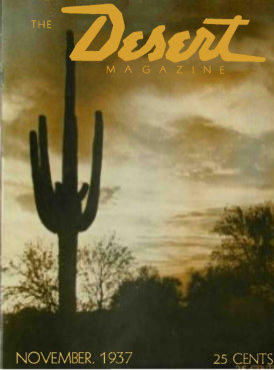
Title: Desert Magazine
Date: November 1937
Publisher: Randall Henderson and J. Wilson McKenney, El Centro, California
Price: 25 cents per copy | $2.50 per year subscription
Significance: First issue — the magazine’s debut and statement of purpose.
1. The Desert, God’s Garden of Peace – Poem by Nellie N. Coffman
A reverent poem from Palm Springs hotelier Nellie Coffman portraying the desert as a sacred retreat. She depicts the desert as “God’s Garden of Peace,” a place of quiet renewal and divine beauty for those seeking rest from worldly struggles.
2. There Are Two Deserts (Editorial) – Randall Henderson and J. Wilson McKenney
The opening editorial contrasts two conceptions of the desert: one as a hostile wasteland, the other as a living, inspirational landscape. It introduces Desert Magazine as a “friendly, personal” publication meant to unite desert residents, celebrate desert culture, and counter public misconceptions about arid lands.
3. No. 1 Adventurer of the Desert – Don Admiral
A natural-history essay about the creosote bush (Larrea divaricata), praised as the desert’s most enduring plant. Admiral explains its adaptive spacing, medicinal uses, and role in Native and pioneer life. The article begins a planned series on characteristic desert plants.
4. The Desert Under a Microscope – J. Wilson McKenney
Profile of Dr. Forrest Shreve, director of the Carnegie Institution’s Desert Laboratory on Tumamoc Hill near Tucson. McKenney visits the lab and describes its studies of desert botany, seed germination, and adaptation. The article humanizes science through Shreve’s humor and dedication.
5. He Helps Keep the Chuckawalla Desert Dry – Randall Henderson
A lively sketch of “Desert Steve” Ragsdale, founder of Desert Center, California. Ragsdale’s blend of humor, perseverance, and entrepreneurial grit illustrates the spirit of early highway pioneers who built services across remote desert routes.
6. “Bold Emory” – J. Wilson McKenney
Historical narrative on Lt. William Hemsley Emory, U.S. Army engineer and diarist of the 1846–47 expedition from Fort Leavenworth to San Diego. McKenney recounts Emory’s mapping, scientific precision, and role in documenting the Southwest during the Mexican-American War.
7. Looking Down from Nevada’s 12,000-Foot Oasis – Randall Henderson
Travel account of a Fourth-of-July climb to Charleston Peak near Las Vegas. Henderson describes alpine meadows, sweeping desert views, and the need to preserve the mountain from automobile intrusion. The essay balances adventure with conservationist sentiment.
8. Navajo Shepherdess (Photograph) – William M. Pennington
A noted photograph accompanied by commentary on “dependence” among sheep, shepherdess, and the desert environment. The piece reflects ecological interconnection and was later hailed as one of Pennington’s finest desert images.
9. The Feel of the Desert – John Stewart MacClary
Profile of photographer William M. Pennington. MacClary recounts Pennington’s early career in Durango, Colorado, his work among Hopi and Navajo peoples, and his patient, respectful method of photographing Native subjects. The essay introduces Pennington as Desert Magazine’s signature visual artist.
10. Lost Tree in a Lonely Land – Lillian Bos Ross
Story of the rediscovery of the Elephant Tree (Bursera microphylla) in the Borrego Desert by Dr. E. M. Harvey and Don Admiral. Ross recounts her own trek to find the tree, blending field exploration with the drama of desert endurance and discovery.
11. Luck — Plus Brains – Jonathan Bart
Feature on Kenneth Holmes, a young mining engineer who, with Ed Nicholson, developed a successful gold operation in Imperial County. The story emphasizes education, method, and perseverance as modern counterparts to old-time prospector “luck.”
12. For This Army — 8000 Grubbing Hoes – Larry D. Wolman
Report on construction of the All-American Canal near the Colorado River. It profiles equipment operators and explains how the project will irrigate over a million acres, linking human labor to desert transformation.
13. Who Knows the Story of This Arizona Landmark? – Prize Contest
Reader contest inviting submissions to solve a historical mystery surrounding an unnamed Arizona landmark. This establishes an interactive feature for readers and desert historians.
14. Sez Hardrock Shorty – Lon Garrison
Humorous fictional sketch introducing “Hardrock Shorty,” a recurring character who would appear for years as the desert’s wisecracking prospector-philosopher.
15. Sandstone Home – Architecture feature
A short illustrated piece on desert homebuilding, promoting use of local sandstone materials suited to arid conditions.
16. The Prospector – Jeff Worth
Poetic meditation on the solitary life and spirit of the desert prospector, closing the issue with a note of rugged individualism and introspection.
Departments and Columns
- Calendar of Desert Events: lists 1937–38 hunting seasons, fiestas, and regional gatherings across Arizona, California, and New Mexico.
- Prize Photograph Contest: invites reader submissions of desert photography.
- Books and Comment: brief reviews of southwestern literature.
- Here and There on the Desert: short news notes and observations.
- Just Between You and Me: closing column by the editor with informal remarks.
Summary Character
The debut issue defines the desert not as empty land but as a landscape of endurance, beauty, and individuality. Its mix of science, poetry, and portraiture frames the desert as both natural wonder and human community. The publication’s editorial tone is idealistic yet practical—part field guide, part cultural journal—and it laid the groundwork for the magazine’s long-running influence across the Southwest.